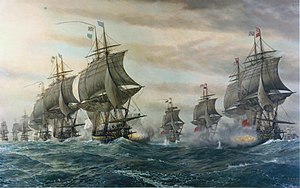Battle of the Chesapeake
| Battle of the Chesapeake | |||||||
|---|---|---|---|---|---|---|---|
| Part of the American War of Independence | |||||||
 The French line (left) and British line (right) do battle |
|||||||
|
|||||||
| Belligerents | |||||||
|
|
|
||||||
| Commanders and leaders | |||||||
|
|
|
||||||
| Strength | |||||||
| 24 ships of the line with 1,542 guns | 19 ships of the line with 1,410 guns | ||||||
| Casualties and losses | |||||||
| 220 killed or wounded 2 ships damaged |
90 killed 246 wounded 5 ships damaged 1 ship scuttled |
||||||
The Battle of the Chesapeake, also known as the Battle of the Virginia Capes or simply the Battle of the Capes, was a crucial naval battle in the American War of Independence that took place near the mouth of Chesapeake Bay on 5 September 1781, between a British fleet led by Rear Admiral Sir Thomas Graves and a French fleet led by Rear Admiral Francois Joseph Paul, the Comte de Grasse. Although tactically indecisive, the battle was strategically decisive, since it prevented the Royal Navy from reinforcing or evacuating the forces of Lieutenant General Lord Cornwallis at Yorktown, Virginia. When the French were able to achieve control of the sea lanes against the British, the result was the reinforcement of the Franco-American army with siege artillery and French reinforcements—all of which proved decisive in the Siege of Yorktown, effectively securing independence for the Thirteen Colonies.
Presented in July 1781 with the options of attacking British forces in either New York or Virginia, Admiral de Grasse opted for the latter, arriving at the Chesapeake at the end of August. Upon learning that de Grasse had sailed from the West Indies for North America, and that French Admiral de Barras had also sailed from Newport, Rhode Island, Admiral Graves concluded that they were going to join forces at the Chesapeake. Sailing south from New York with 19 ships of the line, Graves arrived at the mouth of the Chesapeake early on 5 September to see de Grasse's fleet at anchor in the bay. De Grasse hastily prepared most of his fleet, 24 ships of the line, for battle and sailed out to meet Graves. In a two-hour engagement that took place after hours of manoeuvring, the lines of the two fleets did not completely meet, with only the forward and center sections of the lines fully engaging. The battle was consequently fairly evenly matched, although the British suffered more casualties and ship damage. The battle broke off when the sun set. British tactics in the battle have been a subject of contemporary and historical debate ever since.
...
Wikipedia
